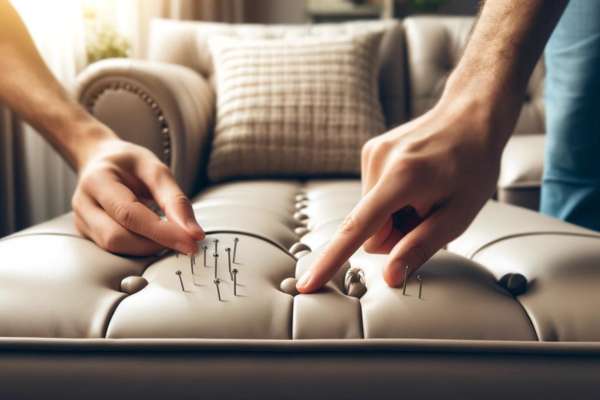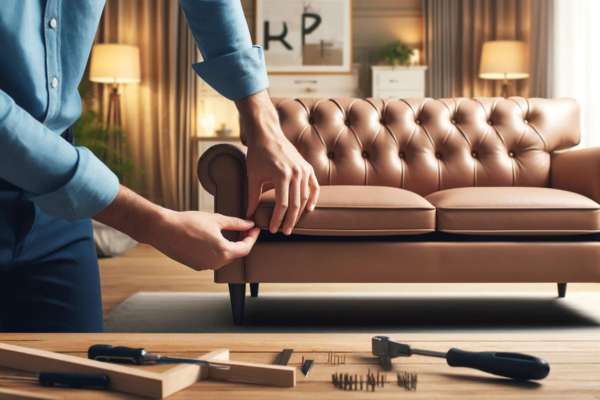Embarking on rearranging your living space or moving to a new home? Knowing how to disconnect a sectional sofa with pins is crucial to ensure a smooth transition. Sectional sofas offer versatile seating options but can be a challenge to separate without the right technique. This guide provides a clear, step-by-step approach to safely and efficiently disassemble your sofa without causing damage to its components. Whether you’re a seasoned DIY enthusiast or tackling this for the first time, our instructions will help you navigate this task with ease, preserving the integrity and longevity of your furniture. Follow along to master the art of disconnecting your sectional sofa with pins effectively.
Understanding Your Sectional Sofa

Understanding your sectional sofa is the first step in safely disconnecting it. Sectional sofas come in various configurations, including L-shaped, U-shaped, and modular designs, each offering unique arrangements suitable for different spaces. The key to these versatile setups lies in the pins that hold the sectional pieces together. These pins are crucial for maintaining the structural integrity of the sofa, ensuring that the sections remain securely attached under daily use. By familiarizing yourself with the type and layout of your sectional, as well as the specific role and placement of the pins, you’ll be better prepared to handle the disassembly process efficiently and safely, preventing any potential damage to your furniture.
Tools and Materials Needed

Before you begin the task of disconnecting your sectional sofa with pins, gathering the right tools and materials is essential for a smooth and safe process. You will need a flat-head screwdriver and a pair of pliers to effectively remove the pins without damaging the sofa. For added convenience, consider having a flashlight on hand to help locate the pins in dimly lit areas. Optional tools such as a rubber mallet can be useful for gently tapping out stubborn pins. Additionally, keep a small container nearby to hold the pins once removed, ensuring they don’t get lost and are ready for when you reassemble the sofa. With these tools at your disposal, you’ll be set to efficiently handle the disassembly of your sectional.
Preparation Steps
Before you begin the process of disconnecting your sectional sofa with pins, proper preparation of the area is key to a successful and damage-free disassembly. Start by clearing the space around your sofa, ensuring you have ample room to move and separate the pieces without obstruction. It’s wise to remove any fragile items from the vicinity to prevent accidental damage. To protect your flooring and nearby furniture, lay down a thick blanket or use furniture pads under the sofa sections. This not only prevents scratches and dents but also makes it easier to slide the pieces apart. Taking these preparatory steps not only facilitates a smoother disconnection process but also safeguards your home’s interiors.
Locating the Pins

When it comes to disconnecting your sectional sofa, the first step is to locate the pins that hold the sections together. Typically, these pins are hidden in the joints between the individual pieces. Start by visually inspecting the seams where the sofa sections meet; you may find small levers or pull tabs indicating the presence of a pin. If your sofa does not have visible signs, gently feel along the edges and creases for any unusual protrusions—these could be the pins. For clearer guidance, consult the manufacturer’s manual, which often includes diagrams showing pin locations. Properly identifying these pins is crucial to ensuring a smooth disassembly process without damaging your sofa.
Disengaging the Pins

Disengaging the pins from your sectional sofa might sound daunting, but with these simple steps, you can do it smoothly and safely. First, locate the pin connectors typically found at the corners where the sections join. Gently pull any fabric covering or flaps away to expose the pins. Using a flat-head screwdriver, apply slight pressure to the pin’s release mechanism. For stubborn pins that seem stuck, a spray of WD-40 or a similar lubricant can work wonders—just give it a minute to soak in before trying again. Always pull the pins straight out to avoid bending them. If the pins are hard to reach, using needle-nose pliers can provide the extra grip and leverage needed to pull them out efficiently.
Separating the Sectional Pieces

Once the pins securing your sectional sofa are disengaged, it’s time to separate the individual pieces. Begin by gently lifting each section away from its neighbors, ensuring not to tug or pull on the fabric or structure harshly. It helps to have an extra pair of hands to stabilize the pieces as they come apart. As you detach each segment, be mindful of any wires or connectors that might be part of reclining features or built-in electronics. Handle each piece with care to avoid any scratches or dents to the sofa or your flooring. Always lift with your legs, not your back, to prevent personal injury. By following these steps, you can safely and effectively separate your sectional sofa without any damage.
Handling and Storing Pins

Once the pins securing your disconnect a sectional sofa with pins are disengaged, it’s time to separate the individual pieces. Begin by gently lifting each section away from its neighbors, ensuring not to tug or pull on the fabric or structure harshly. It helps to have an extra pair of hands to stabilize the pieces as they come apart. As you detach each segment, be mindful of any wires or connectors that might be part of reclining features or built-in electronics. Handle each piece with care to avoid any scratches or dents to the sofa or your flooring. Always lift with your legs, not your back, to prevent personal injury. By following these steps, you can safely and effectively separate your sectional sofa without any damage.
Post-Disconnection Care
After successfully disconnecting your sectional sofa with pins, proper post-disconnection care is essential to maintain its quality and longevity. Start by inspecting each piece for any signs of wear or damage. Clean the sofa components thoroughly using a vacuum with an upholstery attachment to remove dust and debris. For fabric sections, consider using a fabric cleaner or a mild soap solution, ensuring it is safe for the material. Leather pieces can be wiped down with a damp cloth and conditioned with a leather cleaner. Store the pins safely to avoid loss. Additionally, check the connections and hardware for any signs of looseness and tighten them if necessary. Regular maintenance and cleaning will keep your sectional sofa in prime condition for years to come.
Conclusion
In conclusion, mastering how to disconnect a sectional sofa with pins is essential for anyone looking to rearrange their living space or prepare for a move. By following the steps outlined in this guide, you can safely and efficiently disassemble your sectional sofa without causing damage. Properly storing the pins and maintaining the sofa pieces ensures your furniture remains in top condition. Whether you’re a DIY enthusiast or new to furniture disassembly, these tips will help you manage the task with confidence and ease. Remember, careful handling and regular maintenance extend the lifespan of your sectional sofa, making future reassembly and use straightforward and hassle-free.

